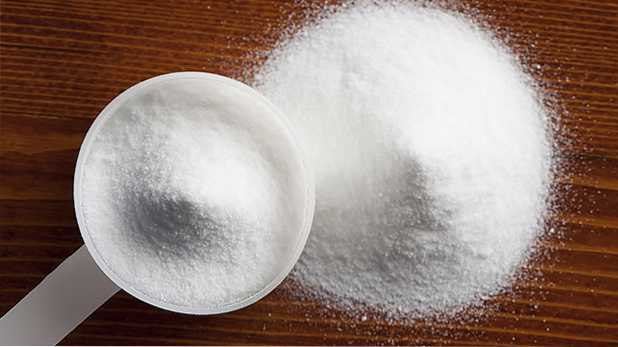
Tip Start Taking This Unknown Amino Acid

As an Amazon Associate, T Nation earns from qualifying purchases. When you buy something, using the retail links in our articles, we may earn a small commission. T Nation does not accept money for editorial reviews. Read more about our policy.
Glycine, alas, isn't very glamorous. Unlike certain “star” amino acids like the branched-chains and the rest of the essential amino acids, glycine keeps to herself, content to wear homemade clothes, can beets for the winter, and relax in her she-shed where she scrapbooks the accomplishments of her more famous siblings.
Alright, I'm getting a little carried away with the anthropomorphization of glycine.
My point is that this “non-essential” amino acid does a whole lot of cool shit and we should all be taking it. So there. Here's a list of just some of the things it does:
1. Glycine Improves Muscle Cell Growth
A couple of studies have found that glycine enhances skeletal muscle growth in pigs, which, physiologically speaking, are a suitable substitute for humans.
It turns out the amino acid activates mTOR (a kinase that controls cell growth), which makes it more like a branched-chain amino than a plain, old, nondescript and non-essential amino acid.
However, glycine appears to have another superpower that the branched-chains don't: It inhibits the expression of genes for proteolysis, and that's a good thing for those interested in muscle growth.
2. Glycine Improves Athletic Performance
Back in 1999, researchers put together a study to see if the amino acid arginine could affect muscle injury and performance during a marathon run. They needed a control amino acid, so they said what the heck and chose glycine.
In an example of biochemical in-your-face, it turned out that it was glycine that enhanced the performance of the runners and not so much the arginine.
3. Glycine Enhances Collagen Synthesis
Throw away your glucosamine and chondritin, at least if you're using them to shore up creaky joints because glycine works better in enhancing collagen synthesis, thereby treating and perhaps even preventing osteoarthritis.
You can probably even stop using collagen supplements, because the main reason collagen works in healing up joints is that it contains comparatively large amounts of glycine.
4. Glycine Might Delay Aging
A Japanese team knew that the GCAT gene was involved in the production of glycine, and when they deactivated the GCAT gene in young fibroblasts (a type of cell that produces the structural framework for animal tissues and plays a critical role in wound healing), their energy expenditure decreased. Conversely, when they activated that same GCAT gene, energy expenditure went up again.
They decided to tinker with things further, but this time, they exposed old fibroblasts directly to glycine and presto, energy levels increased significantly.
Their results suggest that simply adding more glycine to the diet could make old cells act young again and possibly delay aging.
5. Glycine Might Help Improve Leaky Gut Syndrome
When the villi and microvilli of the intestinal lining become damaged or inflamed, they become more porous, allowing microbes and food particles to “leak” through and cause havoc in the body.
Glycine, however, has been found to increase the height of small-intestinal villi, thus possibly reversing leaky gut syndrome and improving nutrient transport in general.

How Much Glycine Should I Take?
Glycine is, of course, one of the 20 or so amino acids that make up a whole protein, so just eating whole proteins is going to supply you with some glycine. For instance, normal folk who don't pay a lick of attention to protein intake inadvertently consume about 2 to 3 grams of glycine a day.
The body usually makes another 2 to 3 grams on its own, usually from serine, but sometimes from choline with a little dash of threonine for spice. However, a lot of the beneficial effects of glycine described above seem to be dose-dependent, with some studies suggesting that an additional 10 grams a day could be beneficial.
Weight lifters normally have a leg up on glycine intake over the average human because they're presumably ingesting a lot of protein already, thereby fortifying their daily glycine stockpile.
Still, I think it's a great idea to ingest an additional 3, 4, or 5 grams of additional glycine a day, either through a collagen supplement, a dedicated glycine powder, or a capsule.
Related: A Cheap, Simple Stack for Healing Injuries
Related: You Need More of This Amino Acid
References
- A.L. Buchman, et al. “The effect of arginine or glycine supplementation on gastrointestinal function, muscle injury, serum amino acid concentrations and performance during a marathon run,” Int J Sports Med. 1999 Jul;20(5):315-321.
- Osamu Hashizume, et al. “Epigenetic regulation of the nuclear-coded GCAT and SHMT2 genes confers human age-associated mitochondrial respiration defects,” Scientific Reports, 22 May 2015, Article number: 10434 (2015).
- de Paz-Lugo P1,2, Lupiáñez JA3, Meléndez-Hevia E4, “High glycine concentration increases collagen synthesis by articular chondrocytes in vitro: acute glycine deficiency could be an important cause of osteoarthritis,” Amino Acids, 2018 Jul 13.
- Shaw G, Lee-Barthel A, Ross ML, Wang B4, Baar K. “Vitamin C-enriched gelatin supplementation before intermittent activity augments collagen synthesis,” Am J Clin Nutr. 2017 Jan;105(1):136-143.
- KaiJi Sun, et al. “Glycine Regulates Protein Turnover by Activating Protein Kinase B/Mammalian Target of Rapamycin and by Inhibiting MuRF1 and Atrogin-1 Gene Expression in C2C12 Myoblasts,” J Nutr. 2016 Dec;146(12):2461-2467.
- Weiwei Wang, et al. “Glycine is a nutritionally essential amino acid for maximal growth of milk-fed young pigs,” Amino Acids, 46, 2037-2045 (2014).



Nimeni nu a comentat acest articol încă.